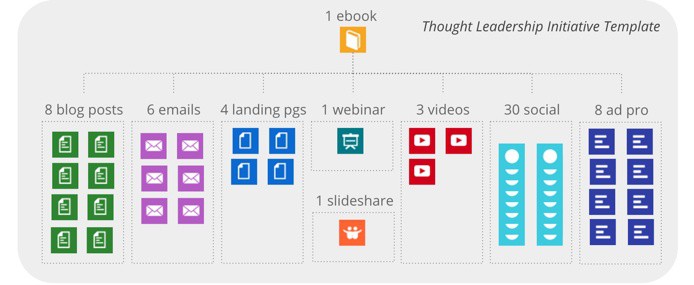Content repurposing is a marketing tactic separates newbies from the experts. It’s at the heart of the content pillar approach.
Did you ever find yourself staring at a blank screen waiting for inspiration to strike?
Creating content is a must in today’s hyper-competitive markets. But, creating any content isn’t enough.
For organizations who (rightly) believed that content is the only thing that can separate them from their competitors, they put tremendous pressure on their marketers to create new content.
But without a holistic digital marketing strategy, or a framework to follow, creating content can be difficult once you exhausted the basics.
This is where content repurposing comes in.
Two Ways to Repurpose Content
If you aren’t familiar with the concept, you can review what content repurposing here.
Also, the best and most effective way to repurpose content is by using a content pillar approach.
Why? You’ll find out below.
With that out of the way, let’s start with an example.
Let’s say you want to create an eBook — The Ultimate Guide to XYZ. This is an example of a content pillar, a significant piece of content that you can break down into smaller pieces of content.
You’ll most likely start outlining what your eBook is all about…
- Introduction
- Chapter 1
- Chapter 2
- Chapter 3
- Chapter 4
- Conclusion
Then, it’s time to actually write the eBook. Below are two ways you can do this.
1. Creating the Content Pillar Option 1: Small to Big
The first way to create a content pillar is to start from the small assets and work your way to form the big one.
As you may already know, each section (or chapter) in the eBook can become its own individual article.
So, instead of writing the entire eBook first, you focus on publishing the first chapter, i.e. the first article. Then, work your way towards the next one, and the next.
This methods allows you to generate interest quickly, and get some initial feedback.
It gives you material to be able to share on social media, email, and everywhere else. It also helps with SEO since you’re churning out new content for your blog.
Follow this strategy until you complete all the chapters you need. Once you have them, put it all together to create the eBook.
You will, of course, have to edit some parts of it to make it flow better.
2. Creating the Content Pillar Option 1: Big to Small
The second way to repurpose content is to create the content pillar first, then break it down into smaller pieces.
Basically, you do everything behind the scenes, then release them to the public in one massive campaign.
One way to go about it is you first launch the eBook through a landing page. You then share this across all your social media accounts and email list.
Then, each day, you release one of the articles with a CTA to the landing page.
Or if you’re doing this already, you can first host a webinar. Then, as soon as you get signups, you release 1 to 2 articles to entice the registrants that this is what you’ll cover in the webinar. After the webinar is done, you release the eBook landing page, and schedule out the rest of the articles.
Again, there are countless ways to do this.
However, I recommend using this option only if…
- You already have existing content pillars
- You already have a regular publishing schedule and this is simply a new tactic you’re implementing.
The main reason for this is there are more benefits for your organization when you go for option 1.
You already know Google and other search engines love new content. So, if you wait for your content pillar to finish, which would probably take several weeks, and you don’t have anything going out of your blog, you’re already behind your competitors who regularly publish something.
In addition, if you don’t have anything new to share, i.e. something educational and helpful, you won’t have anything engaging to share on your social media and email list.
You’d be left with promos and discounts and talking about your products. And we all know that no one really cares about that.
Don’t Forget to Do This After Repurposing Your Content
This is very important that it’s worth mentioning it here.
Once you’re done repurposing your content, regardless of the method you used, don’t forget to distribute it everywhere.
Post the individual articles on social media several times. Me, depending on the article, I post it at least 10 different ways. I use the title and the link; a sentence or two with a link; an image with a quote; and many more variations.
I also send this out to my email subscribers (which you are welcome to join here, by the way).
If it’s relevant, I also include it in the respective lead nurturing campaigns.
I also create several calls-to-action and add it all over my website. This CTA is linked to my landing page, where people can download the eBook I just created.
If you’re unfamiliar about CTAs and landing pages, you can read about how they work together in the typical online conversion path.
What’s Next
Depending on your resources, you can continue with repurposing into other formats or you can stop here.
For example, if you have the resources, you can turn each article into a video. You can then share this to your social media accounts.
You can also use this video and embed it into each article. This is a tactic that you can use to increase your SEO rankings.
And if you’re using video, don’t forget to take advantage of both vertical and horizontal modes. Then add subtitles or captions as well.
You can also create a lead nurturing campaign about this entire topic. For example, you can write an email for each article and link back to it. You can also offer this as a 5-day email bootcamp that discusses about that particular topic.
The ways you can repurpose are virtually endless.
That’s why I strongly recommend using a content pillar approach then repurposing it, instead of an ad-hoc writing where you simply focus on keywords.
Have you tried content repurposing before? If you’re having trouble thinking of how to repurpose your existing content, or simply don’t know where to start, let me know in the comments below. I’d be glad to help out!


